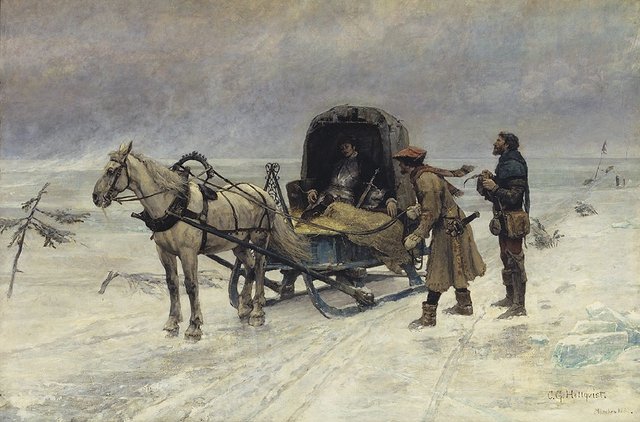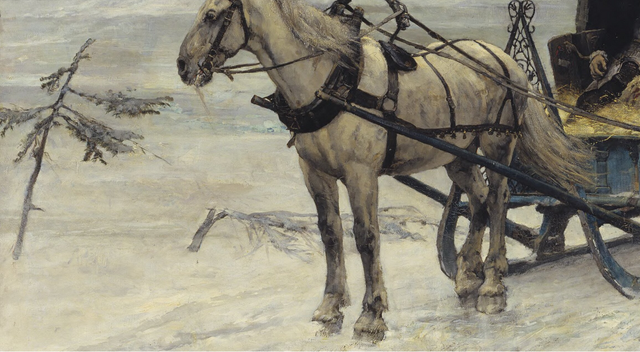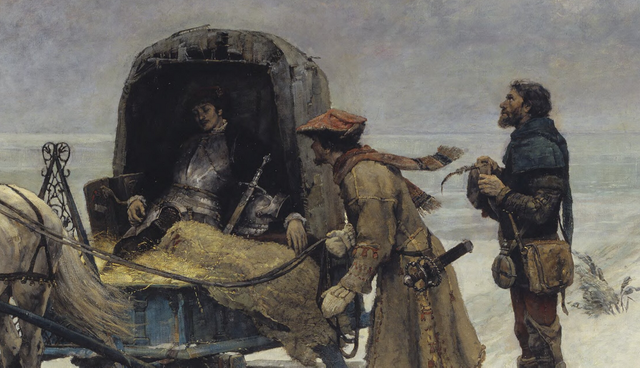[ART] The Death of a Swedish Hero 🎨
During its heyday in the 1870s, historical painting was considered to be the highest of all genres. Today it's regarded as something outdated and even reactionary. Perhaps the greatest Swedish history painter of all is Carl Gustaf Hellqvist (1851-1890), known for his colossal paintings of Swedish kings in different famous historical moments. His most renowned painting is arguably "Valdemar Atterdag Holding Visby to Ransom, 1361", a piece nearly all Swedish schoolchildren get aquatinted with from an early age. In this article we will however look at one of his other great historical paintings; "The Death of Sten Sture the Younger on the Ice of Lake Mälaren" (1880).

On January 19, 1520, the battle of on the ice of lake Åsunden took place between Danish and Swedish forces. It was a bitterly cold day and it snowed profusely. Christian II's 10'000 men stood face to face with just as many Swedes under the leadership of the rebellious Swedish viceroy Sten Sture the Younger, a man who sought independence from the Danes. During the battle, Sten Sture was wounded by a cannonball bouncing off the ice, striking him just above one of his knees and killing his horse. Details about the battle itself are unknown, but the result became a total victory for the Danish army. When Sten Sture fell unconscious from his saddle, the demoralized Swedish peasant army gave up fairly quickly. Sten Sture was laid in a sleigh and his men set full speed east on Lake Mälaren in an attempt to retreat to Stockholm and save his life. But the young regent succumbed to his wound on February 3, 1520, before reaching the capital. His death lead to what is known as Stockholm Bloodbath on 8 November, when King Christian II publicly executed around 100 people from the Swedish nobility and clergy supporting the Sture party. In its turn it lead to a new revolt and a successful liberation war, lead by Gustav Vasa, son to one of the victims of the executions.
Hellqvist has chosen to put the sleigh in a desolate and barren, snowy landscape. The composition is very simple and practically divided into two horizontal parts, sky and ice-covered lake. The painting is most likely not painted outdoors as some have suggested, not least since it's such a large canvas (167 x 250 cm). Instead, he probably did some minor studies at Lake Starnberg, near Hellqvist's studio in Munich. There are a few studies for the painting preserved; a couple of ink and pencil studies of the horse and sleigh, as well as an overall watercolor study.
The sleigh has stopped on a path leading diagonally from right to left in the composition. We can imagine that Stockholm is located in front of the men. The sleigh has just reached land. The firs to the left testify to this. One of the firs is small and pathetic; the other is broken and lies on the snow by the forelegs of the horse. The fir-trees, together with the dark clouds help create the atmosphere of death and decay. The color is cool and subdued and emphasizes the nature of desolation. Overall, the mood is quite somber.


Sten Sture has most likely just taken his last breath. His sword is leaning against a helmet next to him. The man in red hat holding the reins leans forward to see whether or not the king is really dead. The other man behind him has already realized the tragic fact. He wears simpler attire than the coachman and appears to be almost a representative of the entire Swedish people. He's holding his feathered hat in his hands, looking up at the sky and perhaps saying a silent prayer in the hope that the Danes will be merciful.
A simple yet magnificent painting that in a striking and natural way allows us to grasp the poignancy of a hero's death.

Oh yes, the late 19th century is full of historical paintings also over here across the Øresund. Most famous of them is Otto Bache. Your painting here is rather discrete for the genre, it does not attack you like in the semi nationalistic and propagandistic fashion they often do
I agree, this painting manages to avoid the too grandiose, too pompous aspects of history painting.
Undoubtedly a beautiful painting, The sombre colours of grief. The protagonist in stark blackness of the carriage. The horse in a dutiful stance. The muffler catches the cold winds. The story has been most beautifully captured in the painting. Thank you for spreading art knowledge , @steemswede :)
Cool painting - I enjoy this realistic, gritty style with washed-out palate. It works well for grim scenes!
Its easy to forget that Sweden was once a great empire, ruling and fighting over large swathes of Baltic coastline .
Indeed, and it was actually thanks to the House of Vasa that came to power after the liberation war I mention in the article that we became an empire. Today, we're but a nation of weaklings willingly handing our heritage over to foreign interest.